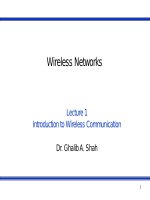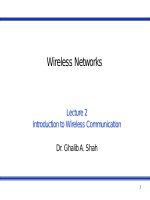Wireless networks - Lecture 20: EDGE
Bạn đang xem bản rút gọn của tài liệu. Xem và tải ngay bản đầy đủ của tài liệu tại đây (458.85 KB, 23 trang )
Wireless Networks
Lecture 20
EDGE
Dr. Ghalib A. Shah
1
Outlines
Last Lecture Review
Walsh Codes
IS-95 Reverse Link
EDGE Introduction
Modulation and Coding Schemes
Link Adaptation and Incremental Redundancy
Capacity Planning
Dynamic Abis pool
2
Last Lecture
IS-136
CDMA/IS-95
Advantages
►
Drwabacks
►
Pilot Channel
Sync Channel
Paging
Traffic
IS-95 Reverse Channels
►
►
Self-jamming, near-far problem, soft handoff
IS-95 Forward Channels
►
►
►
►
Frequency diversity, multipath resistance, privacy, graceful
degradation
Access Channels
Traffic
Next Lecture
3
Forward Link Channel Parameters
Channel
Sync
Paging
Traffic rate Set 1
Traffic Rate Set 2
Data rate (bps)
1200
4800
9600
1200
2400
4800
9600
1800
3600
7200
14400
Code repetition
2
2
1
8
4
2
1
8
4
2
1
Modulation symbol
rate (sps)
4800
1920
0
19200
19200
19200
19200
19200
19200
19200
19200
19200
PN Chips /
modulation symbol
256
64
64
64
64
64
64
64
64
64
64
PN Chips / bit
1024
256
128
1024
512
256
128
682.67
341.33
170.67
85.33
4
Walsh Codes
2x2 Walsh Matrix
1
1
1
-1
User 1 (1, 1) and user 2 (1, -1)
4 x 4 Walsh matrix
1
1
1
1
1
-1
1
-1
1
1
-1
-1
1
-1
-1
1
5
IS-95 Reverse Link
Consists of upto 94 logical channels each
occupying same bandwidth of 1228 KHz.
It supports 32 access channels and 62 traffic
channels
Access channel is used to initiate a call, to
respond to paging channel and for location
update
In reverse, convolutional encoder has a rate of
1/3, thus trippling the effective rate to a max of
28.8 kbps
6
IS-95 CDMA Reverse Channel
Uses OQPSK for power efficiency and QPSK
demodulation is easy
869-894 MHz range.
No spreading of the data using orthogonal
codes
► Data coming out of the block interleaver are grouped
in units of 6 bits that serves as an index to select a
row of the 64x64 Walsh matrix and that row is
substituted for the input
► Thus data rate is expanded by a factor of 64/6 to
307.2 kbps
7
Enhanced Data rates for GSM Evolution
GPRS data rates still fall short compared to
that promised by 3G.
The delay in deployment of 3G technology led
to the emergence of EDGE
Phase 1 (Release’99 & 2002 deployment)
supports best effort packet data at speeds up
to about 384 kbps
Phase 2 (Release’2000 & 2003 deployment)
will add Voice over IP capability
8
GPRS Architecture
Similar to GPRS but
some changes for higher
data rates. Important
change is modulation
scheme
EDGE Functionality
Other GPRS
PLMN
GGSN
SGSN
BSC
BTS
MS
GGSN
BTS
EIR
HLR
MSC/VLR
9
GMSK is used in GPRS, only one bit per
symbol is used
In EDGE, Octogonal PSK (8-PSK) is used
which enables a threefold higher data rate of
59.2 kbps per radio time slot.
► Achieved by transmitting 3 bits per symbol.
GMSK has constant amplitude modulation
while 8-PSK has variations in amplitude.
This changes the radio frequency
characteristics requiring changes in BS.
10
minor changes in hardware and software in
existing systems, leads to major changes in
network performance.
Radio network Planning
► Coding Scheme: nine modulation and coding
schemes (MCS) that provide different throughput as
shown in table
11
12
Payload Format
MCS3
Fa mily A
37 octets
37 octets
37 octets
37 octets
MCS6
MCS9
MCS3
34+3 octets
Fa mily A
padding
34+3 octets
MCS6
34 octets
34 octets
34 octets
34 octets
MCS8
MCS2
Fa mily B
28 octets
28 octets
28 octets
28 octets
MCS5
MCS7
MCS1
Fa mily C
22 octets
22 octets
MCS4
13
► Based on this coding, a data rate of 8 x 59.2 =
473kbps can be achieved
► Though GMSK is more robust but 8-PSK gives more
throughput
► However increased data rate comes at the price of
decreased sensitivity of the system. This has impact
on coverage and in turn network planning
► Another advantage in EDGE is that switching
between different coding schemes takes place easily
i.e. data block can be sent with better protection on
failure
► not possible in GPRS to switch to different coding
scheme on reception failure, retransmission uses the
same protection as for its initial transmission
14
Link Adaptation and Incremental
Redundancy
Link Adaptation (LA)
► As propagation condition changes, quality of signal
changes MCS changes all the time
► LA is used for maximizing the throughput per
channel by changing the coding scheme
► LA algorithms are based on bit error probability
(BEP) measurements
Incremental redundancy
► Improves the throughput and is done by
automatically adapting the transmitted redundancy
to the channel conditions
► Achieved through ARQ and FEC
15
Incremental Redundancy (IR)
Send redundancy only if necessary
Generalized Type-II ARQ
► Finer granularity of code rate
Example Data
Parity
Transmitter
1st attempt
Rate 1
2nd attempt
Rate 1/2
3rd attempt
Rate 1/3
Receiver
16
State Diagram for IR
Initial data
transmission
Data
Block
ARQ
Block
in error
Transmit
parity or
data subblock
Block
in error
Error
Detection
Error
Detection
No error
No error
Accept data
block
Deliver to upper layer
17
Capacity Planning in EDGE
Similar to GPRS but high throughput per radio time slot changes
some aspects of planning
The reuse pattern defines the number of cells in a cluster using
different frequencies.
A frequency reuse of 3/9 means that each f is used only once in
three sites/cluster, wherein each site is three sectored
Reuse for control and reuse for traffic channels are independent of
each other
The actual reuse employed - for traffic or control - is operator
controlled and limited only by the available spectrum
Typically, 4/12 is used for control and 1/3 for traffic. However,
other combinations are also possible subject to performance
requirements, environment and spectrum availability.
Higher the f reuse, higher the throughput and less delay
Time slot capacities have dynamic range depending on users.
18
1/3 Frequency Re-use (EDGE Compact)
• 3 x 200 kHz carrier, reused in every site
• <1MHz x 2 initial deployment
• 3 sectors per site
19
EDGE-capable and non-EDGE-capable TRX in a one
sector can be configured to have only one BCCH
TBF parameter setting makes it possible for TBFs of
GPRS and EDGE radio network to be multiplexed
dynamically on one time slot
However this should be avoided as the performance
suffers in both the uplink and downlink
► In UL, GPRS suffers due to large amount of 8-PSK
retransmissions.
► In DL, it is due to GMSK modulation where 8-PSK can carry
higher data rate for EDGE
20
Dynamic Abis in EDGE
Interface between BS and BSC
However voice signals are still carried in 16 kbps Abis
channels and static for GSM/GPRS
8-PSK changes data rate from 8.8 kbps to 59.2 kbps,
which is insufficient for data beyond MCS2
This data rate is not always there and so dynamic Abis
concept is used in EDGE
BSC allocates Abis capacity from dynamic Abis pool
(DAP) for data calls from EGPRS when needed
21
Benefits
For Operators
► Mig ratio n to wire le s s multime dia s e rvic e s
► Impro ve d c us to me r s atis fac tio n
► Po s s ibility o f e arly marke t de plo yme nt o f third
g e ne ratio n type applic atio ns
For Users
► Impro ve d quality o f s e rvic e
► Pe rs o nal multime dia s e rvic e s
► Po te ntially lo we r pric e pe r bit
22
Summary
Walsh Codes
IS-95 Reverse Link
EDGE Introduction
Modulation and Coding Schemes
Link Adaptation and Incremental Redundancy
Capacity Planning
Dynamic Abis pool
Next Lecture
► WCDMA
23









